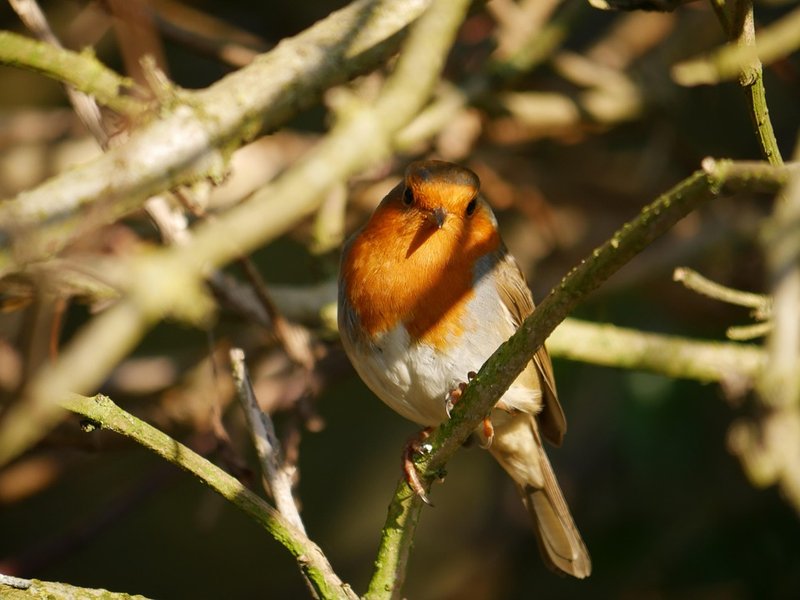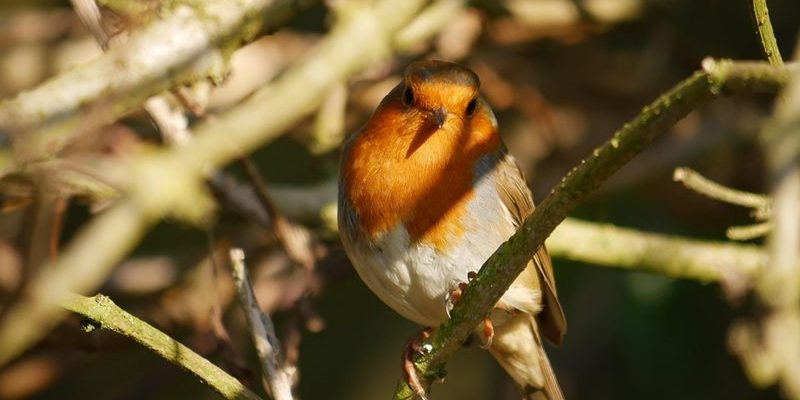
Have you ever heard the delightful song of a robin and felt a surge of warmth? These little birds are often associated with the arrival of spring, making them a symbol of renewal and hope. With their bright orange-red chests and cheerful melodies, robins seem to bring a sense of joy wherever they go. But there’s so much more to these fascinating creatures than their pretty appearance and lovely tunes.
Robins, particularly the American robin, are a common sight in gardens, parks, and backyards across North America. Their friendly nature and curious behavior make them a favorite among bird watchers and nature enthusiasts. Whether you’re looking to identify one in your yard or simply want to learn more about them, this article will guide you through everything you need to know about robins—from their habitat and diet to their unique behaviors and conservation status.
Physical Characteristics
The robin is perhaps one of the most recognizable birds thanks to its unique appearance. Adult robins have a characteristic rounded body, long legs, and a short tail. Their feathers are primarily a soft, grayish-brown color, but it’s that stunning orange-red breast that really stands out. This coloration is vibrant and can vary slightly between individual birds, often becoming more intense during the breeding season. Male robins are usually brighter than females, making it easier to spot them.
On average, adult robins measure around 10 inches in length and have a wingspan of about 12 to 16 inches. They weigh anywhere from 5.5 to 11 ounces. The differences in size can depend on factors such as age and geographic location. For instance, robins in colder climates might be slightly larger than their warmer-climate counterparts, which helps them adapt to their surroundings.
Robins also have a distinctive yellow bill that is slightly curved, perfect for their foraging lifestyle. Their sharp eyesight allows them to spot worms, insects, and berries from a distance, making them effective hunters when searching for food. Overall, the robin’s physical traits not only make it a beautiful bird but also perfectly adapted to its environment.
Habitat and Range
Robins are highly adaptable birds. They thrive in a variety of habitats, including forests, urban areas, and suburban gardens. You can find them perched on trees, hopping around on the ground, or even taking a quick bath in your birdbath. They prefer areas where there’s a mix of open spaces and cover to hide from predators.
In North America, the American robin has the widest range of any robin species. They are found from Canada all the way down to Mexico, adapting well to whatever environment they find themselves in. During the winter, robins tend to migrate south, though some choose to stay in milder climates where food is still available. You might be surprised to learn that even in colder regions, robins can be seen during winter months when there’s a food source, such as berries.
Robins are also known to change their habitat based on the changing seasons. In spring and summer, they often move towards more wooded areas to breed, while in fall and winter, they migrate to more open spaces where they can find food more easily. This adaptability is a significant factor in their success as a species.
Diet and Foraging Behavior
When it comes to their diet, robins are omnivorous, which means they eat both plants and animals, giving them a well-rounded diet. Their favorite food? Earthworms! Robins are famous for pulling these wriggly critters from the soil, especially after rain when they are more visible. This is often a spectacular sight—you might see a robin hopping around your yard with a worm in its beak, proudly showcasing its find.
In addition to worms, robins enjoy a variety of other foods. They feast on insects, fruits, and berries. During the summer months, you might notice them enjoying ripe berries from bushes and trees. Some of their favorites include strawberries, blueberries, and blackberries. They are also quite skilled at foraging for food, often probing the ground for hidden treats or flying up to branches to pick ripe fruits.
Robins have excellent vision, which aids them in spotting food from a distance. They often listen for the sounds of their prey moving in the grass. The classic head tilt you see in robins is actually a method they use to listen for earthworms and other underground insects. This hunting strategy, combined with their adaptability, make robins quite successful in finding food wherever they are.
Breeding and Nesting
Breeding season is an exciting time for robins. Typically, they start nesting in early spring, often building their nests in trees, shrubs, or even on ledges of buildings. The nests are usually made from grass, twigs, and mud, creating a sturdy and comfortable home for their young. You might be surprised to learn that robins are quite protective of their nesting sites and will defend them fiercely against intruders.
After the female lays her eggs, which are usually about 3 to 5 blue or bluish-green eggs, she incubates them for about two weeks. During this time, the male will often bring her food to help. Once the eggs hatch, both parents play a crucial role in feeding the chicks, which are born helpless and rely completely on their parents for survival.
It’s fascinating to watch the progression of the chicks as they grow. Within a couple of weeks, they’ll fledge, or leave the nest, ready to start their lives. The parents continue to care for them for a short period after they fledge, helping them learn to find food and navigate the world around them. This nurturing behavior is crucial for their survival, especially in their early days.
Behavior and Social Structure
Robins are often seen as sociable birds. They are frequently found hopping around in small groups, especially during feeding times. However, they can also be territorial, particularly during the breeding season when males often engage in song battles to defend their territory. Their melodious songs not only attract females but also warn other males to stay away. You might find yourself captivated by the beautiful evening melodies that they croon from high perches.
While robins can be seen roaming around alone, they exhibit a wide range of behaviors. When foraging, you might observe them pause frequently, listening and scanning their surroundings. This keen awareness helps them avoid danger while they search for food. Additionally, robins are known to partake in dust baths, which not only helps keep their feathers clean but also provides relief from pesky parasites.
Interestingly, robins have also been observed forming loose flocks during the winter months. This behavior is essential for survival as it helps them find food more efficiently and provides safety in numbers. While they may seem independent during breeding season, they are clearly resourceful and adaptable, traits that help them thrive in various environments.
Conservation Status
The conservation status of robins is generally stable, and they are not considered endangered. Their adaptability to different environments has allowed them to thrive in urban areas and suburban settings. However, like many species, they face challenges from habitat loss, climate change, and pollution. It’s crucial to continue monitoring their populations to ensure they remain a common sight in our gardens and parks.
One positive aspect is that robins have successfully adapted to human presence. Providing bird-friendly environments—like native plants, water sources, and natural nesting areas—can help support their populations. Simple actions like reducing pesticide use or creating bird-friendly gardens can make a big difference in promoting a healthy ecosystem for robins and other wildlife.
While there are currently no major threats to robins, the changing climate poses potential challenges. As weather patterns shift, food availability might fluctuate, and migratory routes could become disrupted. Being mindful of our environmental impact can help ensure that future generations can appreciate the beauty and joy that robins bring into our lives.
Interesting Facts About Robins
| Size: | 10 inches long |
| Wingspan: | 12 to 16 inches |
| Weight: | 5.5 to 11 ounces |
| Diet: | Omnivorous (worms, insects, fruits) |
| Nesting: | 3 to 5 blue eggs |
| Life Span: | Up to 6 years in the wild |
| Migration: | Seasonal (sometimes year-round in warm climates) |
FAQ
What is the lifespan of a robin?
Robins have a lifespan that typically ranges up to 6 years in the wild, although some may live longer under ideal conditions. Factors that impact their longevity include food availability, predation, and environmental conditions. In captivity, where they face fewer threats, robins have been known to live even longer.
Do robins migrate?
Yes, many robins are migratory birds. They tend to migrate south in the winter to find warmer temperatures and more readily available food sources. However, some robins may choose to stay in milder climates throughout the winter, depending on local weather and food availability.
Are robins solitary or social birds?
Robins can be both solitary and social. While they are often seen foraging alone, especially during the breeding season, they do enjoy the company of other robins, particularly when feeding or during migration. Their social structure can vary based on the time of year and environmental conditions.
What sounds do robins make?
Robins are known for their melodious songs, which they use to communicate with other robins, attract mates, and defend their territory. Their song is often a series of cheerful whistling notes that can brighten up any morning. They also make various other sounds, including chattering and alarm calls.
How can I attract robins to my yard?
Attracting robins to your yard is easier than you might think! Start by providing a habitat that includes native plants for food, like berry bushes. Adding a birdbath can also be very appealing to them. Avoid using pesticides, as this will help ensure a safe environment for robins and the insects they eat.
Do robins eat seeds?
While robins primarily eat insects and fruits, they do occasionally consume seeds. They might take advantage of seeds, particularly in winter, when other food sources are scarce. This can include seeds from grasses or weeds, and you can consider putting out a birdseed mix during the colder months.
What do robin eggs look like?
Robin eggs are known for their beautiful sky-blue color, often described as a vivid blue or turquoise. The eggs are slightly speckled and measure about 1 inch in length. They are typically laid in clutches of 3 to 5 eggs, which the female incubates for about two weeks before they hatch.
What do robins symbolize?
Robins are often seen as symbols of renewal and hope since their arrival in spring closely aligns with the changing of the seasons. They represent new beginnings, much like the blooming flowers and the return of warm weather. Many people find their presence uplifting and a reminder of the beauty of nature.
What predators do robins have?
Robins face various predators, including hawks, cats, and snakes. Nestlings and eggs are particularly vulnerable, so robins have adapted by building their nests in sheltered areas and keeping a keen lookout for potential threats. Their alert nature helps them avoid many dangers.
Can robins recognize human faces?
Research suggests that robins can indeed recognize human faces, especially those who frequent their territory. They can distinguish between friendly and threatening people, which adds a level of fascinating interaction to their behavior. This ability likely helps them navigate their environment more safely.
How can I help protect robins?
You can help protect robins by creating a bird-friendly environment in your yard. This includes planting native plants, providing clean water sources, and refraining from pesticide use. Participating in local conservation efforts and spreading awareness about the importance of protecting bird habitats can also make a big difference in ensuring robins continue to thrive.

